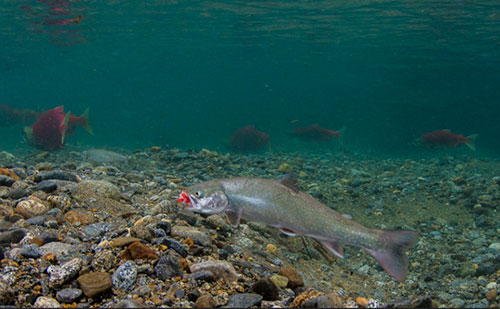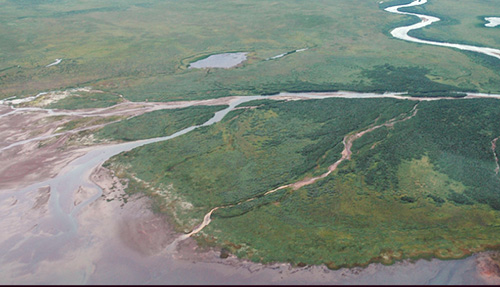
Alaskan trout choose early retirement over risky ocean-going career
October 31, 2015
After making an exhausting migration from river to ocean and back to river -- often multiple years in a row -- one species of Alaskan trout decides to call it quits and retire from migrating once they are big enough to survive off their fat reserves. This is the first time such a "retirement" pattern has been seen in fish that make this river-to-ocean migration, according to University of Washington-led research published in July in the journal Ecology. Dolly Varden, a common and abundant trout in Southwest Alaska's rivers, live mainly in freshwater streams, but travel to the ocean in the summer months to feed and grow. This migration pattern, called anadromy, is seen in salmon and steelhead as well as some cutthroat and bull trout.
Dolly Varden consuming eggs during sockeye spawning in Chinkelyes Creek, Alaska.
The study shows that Dolly Varden, once they reach about 12 inches in length, can retire permanently from going to sea. They rely on digestive organs that can massively expand and contract and a unique relationship with sockeye salmon. "As far as we know, no one has ever seen a population of large-bodied fish come back to freshwater and just park there for the rest of their lives," said lead author Morgan Bond, a postdoctoral researcher at the National Oceanic and Atmospheric Administration who completed this work as a UW doctoral student. Dolly Varden trout, perhaps the lesser-known cousin of Alaska's famous sockeye salmon, are abundant in the relatively untouched Alec and Chignik rivers of the Alaska Peninsula. Every summer, sockeye also spawn by the hundreds of thousands here, and an excess of salmon eggs is left floating in the rivers or collecting in clusters along the bank. These eggs become a short-lived nutritious meal for other species, namely Dolly Varden trout. Dolly Varden binge on the eggs for about a month, doubling or quadrupling the size of their stomach and intestines to accommodate the feast. Then, once the salmon spawning ends, Dolly Varden shrink their guts and survive for the next year off their reserves in cool water because there is little else to eat in the rivers. Small Dolly Varden will migrate out to the ocean in early summer to eat even more, trying to get big enough to stay in the river next season -- and for the remainder of their lives. "Small fish gain enough to make this risk worthwhile because they can pack on a good deal of growth in a summer at sea," said senior author Tom Quinn, a UW professor of aquatic and fishery sciences. "However, fish that are already big will only grow a bit more, and there are still predators that can eat them. So, in this case the big fish retire from anadromy at a certain age and stay in the river, waiting for the ocean to come to them -- in the form of the eggs released by the salmon." The researchers observed this pattern by looking at the ear bone, called an otolith, of more than 300 Dolly Varden fish. When cross-sectioned, otoliths show a growth ring for each year of life, providing the age of the fish. Otoliths also record natural variation in water chemistry. Marine water has a higher concentration of the element strontium, so a spike in strontium on a fish's otolith means it migrated to the ocean that year.
Alec River and Black Lake
In both cases, they would be forced to seek a new feeding pattern. "This population is clearly on the edge between two extremes, and their life history patterns could shift to complete residency or anadromy depending on climate change and the health of the other species they interact with," Bond said. Other Pacific trout, including sea-run cutthroat and bull trout, which are listed as threatened in Washington, might also retire given the right ecological circumstances. More studies are needed to know whether this is happening, though it's likely the trout wouldn't have access to the same abundance of salmon eggs, researchers said, because the spawning activity in Washington's rivers is much less than in Alaska. The research took place as part of the UW's long-tenured Alaska Salmon Program, where scientists are studying a range of issues including population genetics, migration patterns and the relationship between salmon and bears. The program is the world's longest-running effort to monitor salmon and their ecosystems.
Editor's Note:
Edited by Mary Kauffman, SitNews
Source of News:
|
||

